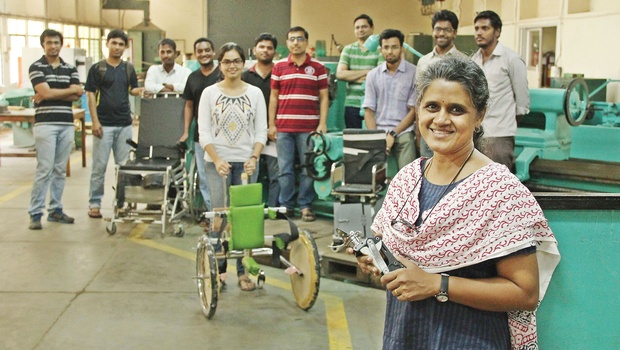
For those expecting a serious looking individual with a starchy manner and an intimidating persona are in for a pleasant surprise when one encounters Dr Sujatha Srinivasan who greets you with a hearty handshake and an all-embracing smile. Chatting nineteen to a dozen, she leads to the lab where her students are at work. She explains, “We are in the process of developing assistive devices for people affected by locomotor impairments. These people can lead independent lives via the use of orthotic, prosthetic and other assistive devices.”
Srinivasan is an associate professor and head of the Rehabilitation Research and Development Centre (R2D2) in IIT-Madras. The centre is Srinivasan’s ‘brainchild’. She is a BTech (Mechanical) from Indian Institute of Technology-Madras. After graduation in 1991, Srinivasan worked in Christian Medical College, Vellore in the area of bio-mechanics. Later, she spent 15 years in the US, of which eight was spent in working in prosthetic industry. Declining lucrative job offers from reputed companies in India and abroad, Srinivasan felt her ‘call in life’ was research and development in the field of bio-engineering, to focus on a unique environment for assistive device development to provide for the country’s rehabilitation needs. With this in mind, she returned to India in 2008.
“Multiple sclerosis, amputations due to diabetes and aging are some of the common factors where patients are compelled to spend the rest of their lives in wheel chairs. Here we design physically related devices that keep the differently abled comfortable while allowing them mobility. For example, a polycentric knee allows bending, provides stability while walking. The device is externally used and is made of stainless steel and aluminium. Further, prolonged use of the wheelchair comes with serious side-effects like pressure sores. In view of this, we have developed a standing wheel chair which by rotating the lever the patient can stand for some time. We have developed it from scratch,” she admits proudly. Further, they have devised chairs that are mobilised by the children with cerebral palsy where motor skills are affected and for those with different kinds of disability. Since these children cannot use their hands to rotate the wheels of the chair, they have come up with this new technology—a body-motion controlled wheel chair—in which the chair moves in the direction the child moves.
The ‘Saathi Walker’ is another device developed to help children with no physical stability—the walker supports the child when it walks. Apart from all these devices, the most unique is the ‘Swimming Pool Lift’, an electric chair that gently drops the patient into the pool and lifts the patient back to the top. This was inspired by Madhavi Latha, a polio-inflicted banker, who when given up by doctors was advised to try hydro-therapy and went on to become a paralympic swimming champion in 2012. “Of course, we are trying to develop the chair manually as electricity comes with its own hazards and power in our country is a luxury!” she opines. Though the centre has adopted the concept of developing prosthetics from the West, they have changed the geometry to suit Indian terrain and are also looking at additional features like adding a rotator to the chair so that the patient can sit cross-legged on the floor.
Any initial struggles in setting up the centre? “Not much,” she replies, adding, “When the idea was first suggested to the IIT, they were very supportive. Regarding funding, TTK Prestige Co. chairman T T Jagannathan have helped us enormously; Society for Biomedical Technology and other organisations have helped considerably too. Phoenix Medical Systems has been constructively supportive in manufacturing wheel chairs of high quality at affordable prices. TTK Prestige is also our potential manufacturer with the same goal in mind.” About challenges, she says: “Trying to develop the product with a floating population of students who move on once the study course is complete is difficult as the new ones do not want to complete what someone else started. But we have overcome that now by employing them here on a salary basis.” Srinivasan aims at functionality and affordability to develop quality devices at affordable costs for all. The centre works in parallel with manufacturers to modify designs to suit easily available materials and are also working with NGOs and established manufacturers to commercialise the designs at affordable prices. Ananth from the Mechanical Engineering Department is seen working diligently on the computer and on the table is a pair of stainless steel device meant for the knees. He plans to open his own manufacturing company in conjunction with the R&D centre, while Vivek with a masters degree is satisfied with and encouraged by the research work at the centre.
source: http://www.newindianexpress.com / The New Indian Express / Home> LifeStyle> Health / by Uma Balasubramaniam / February 21st, 2015